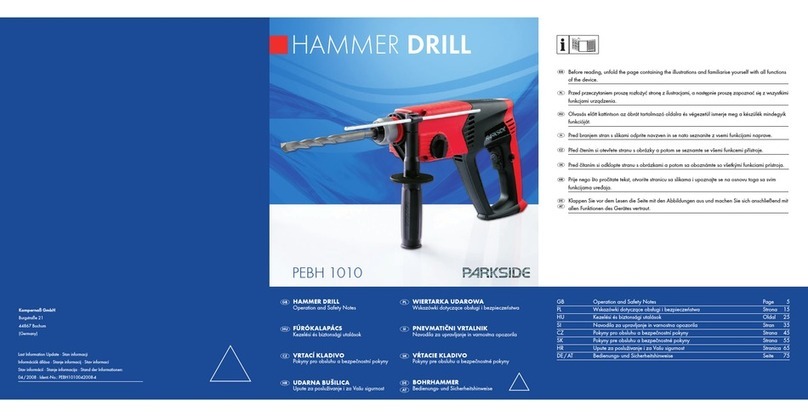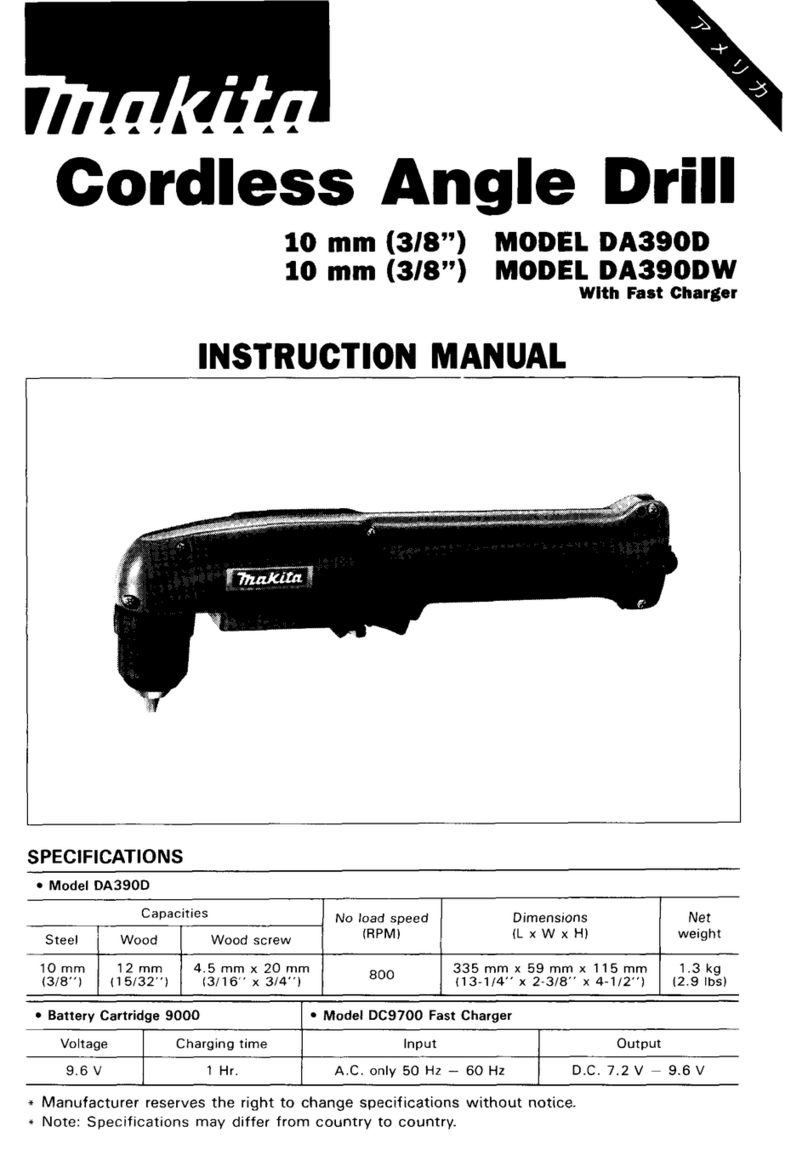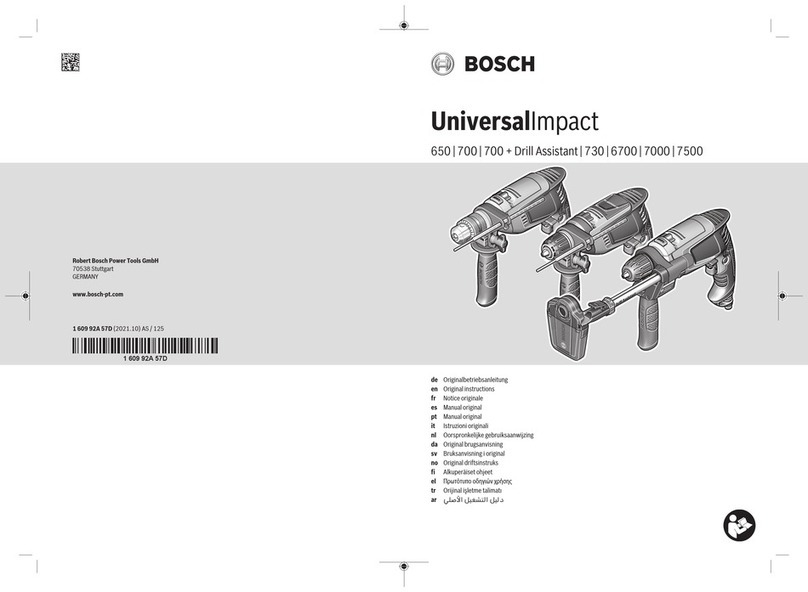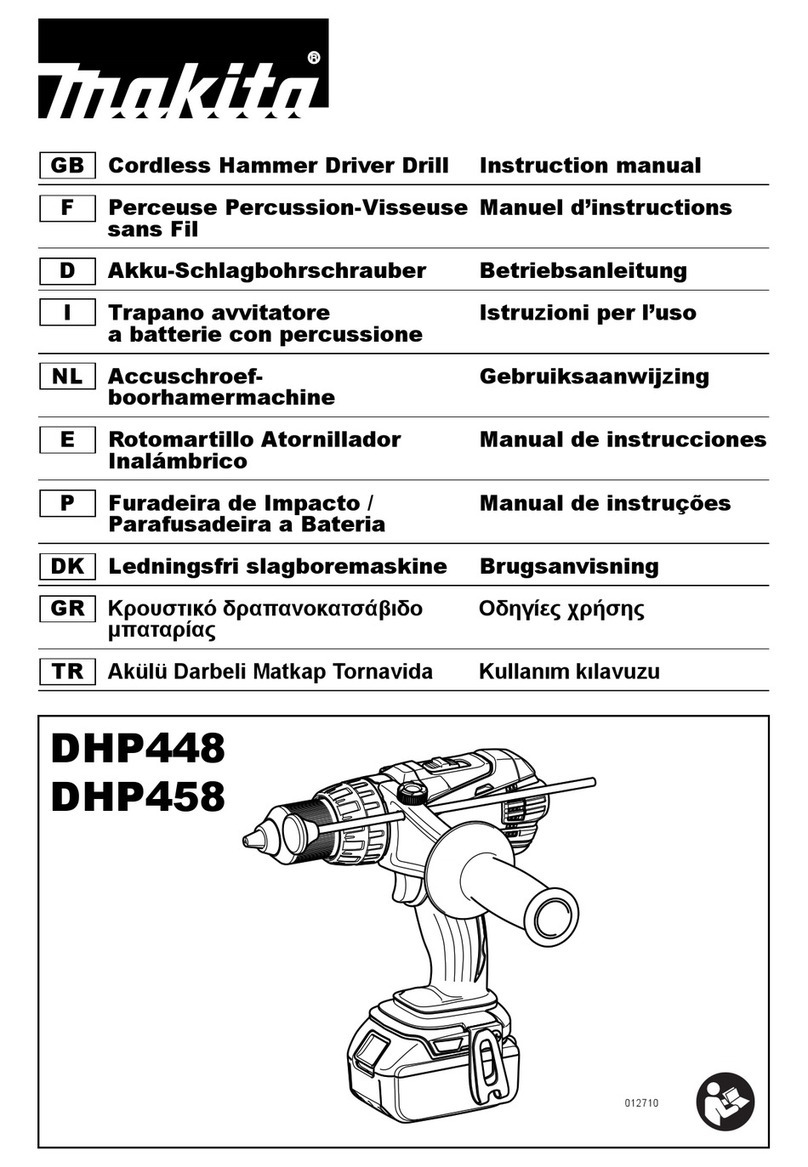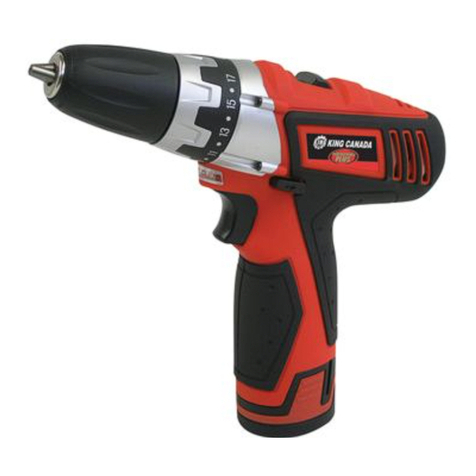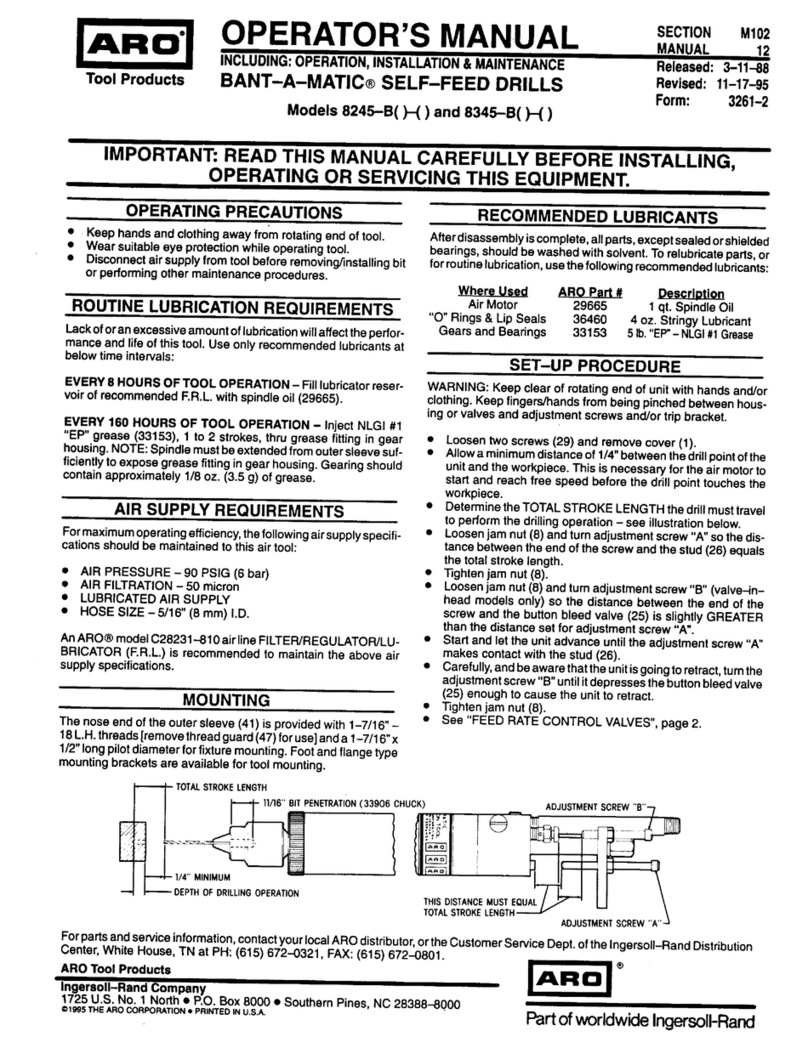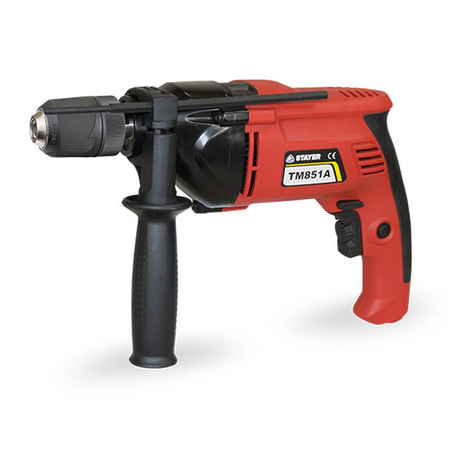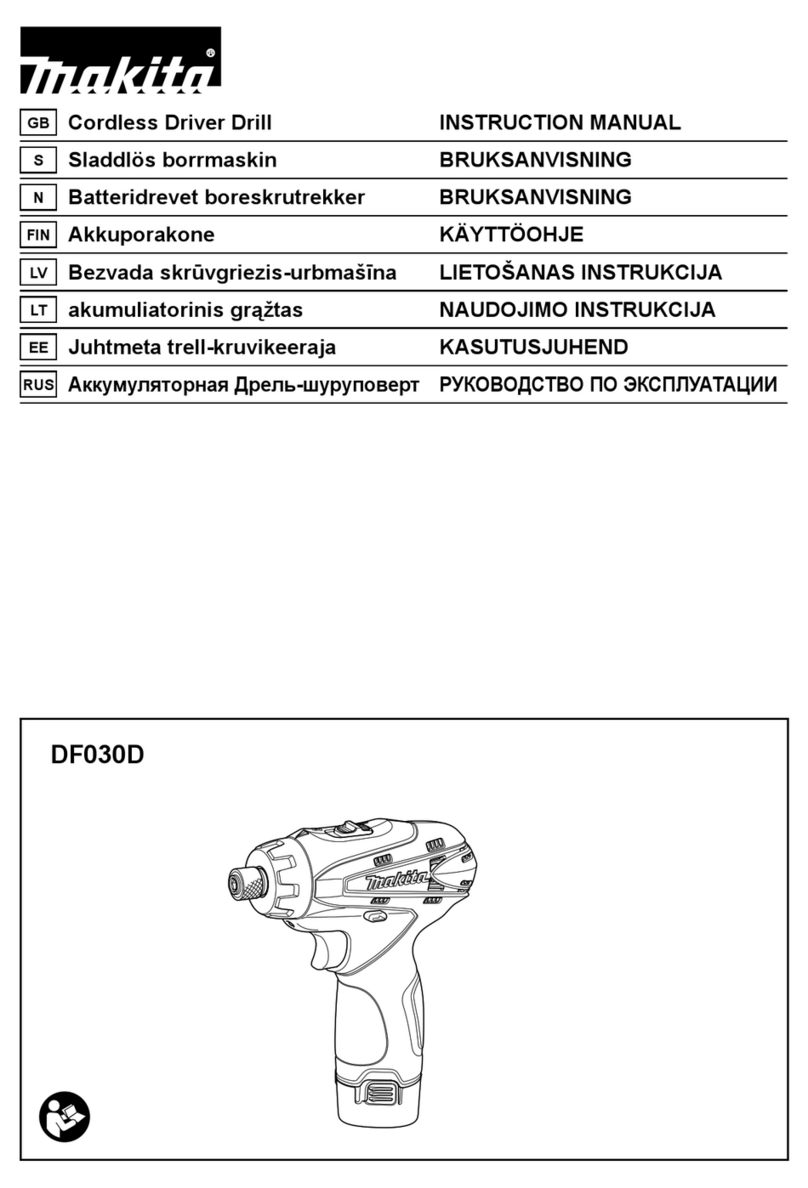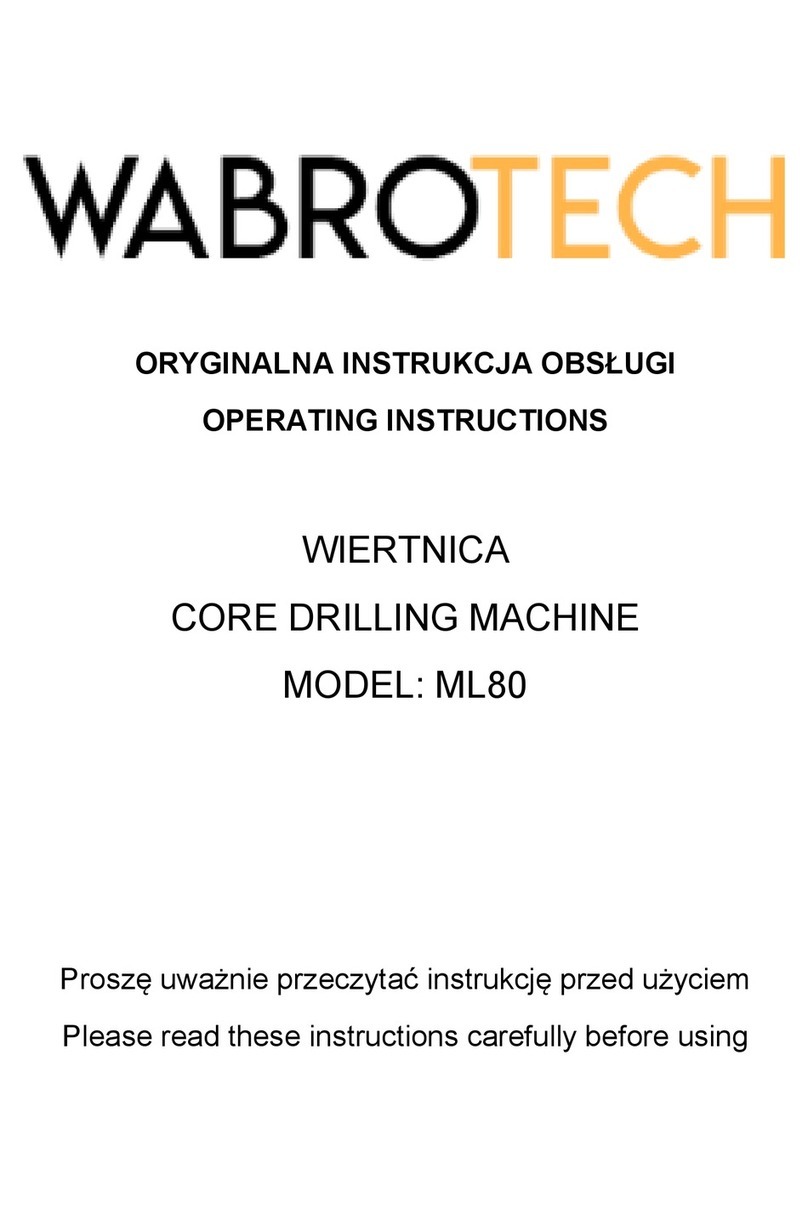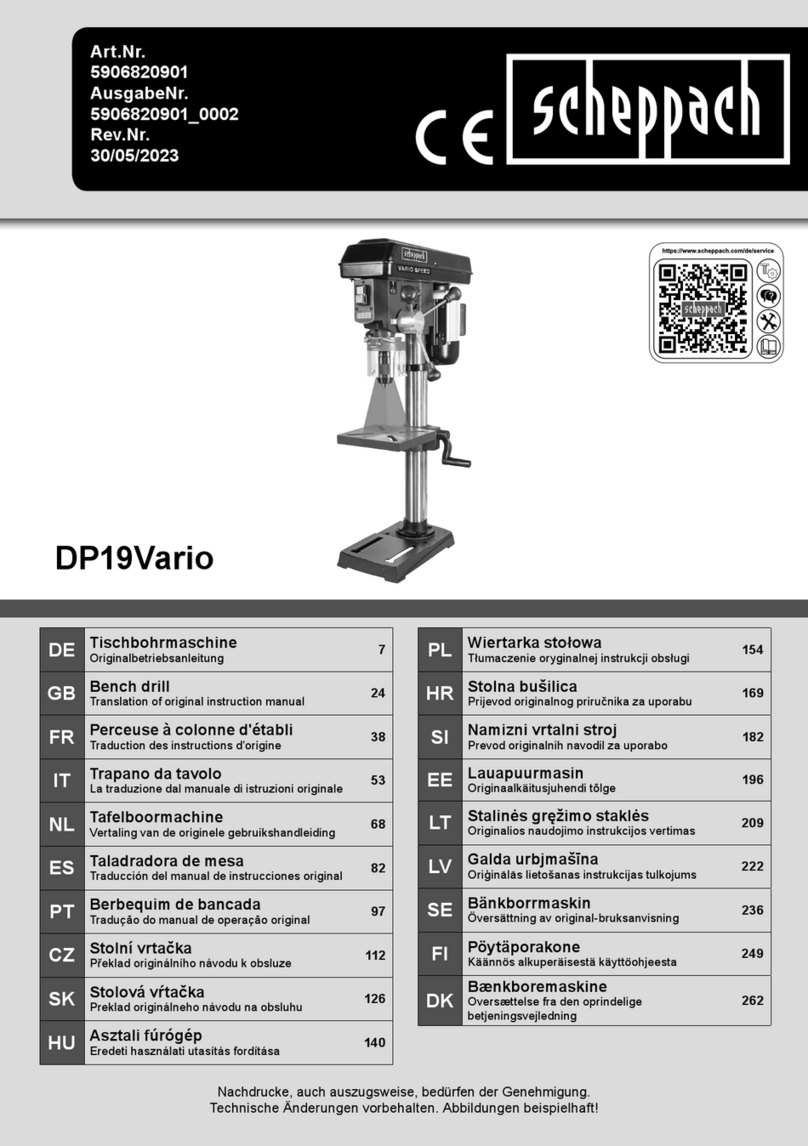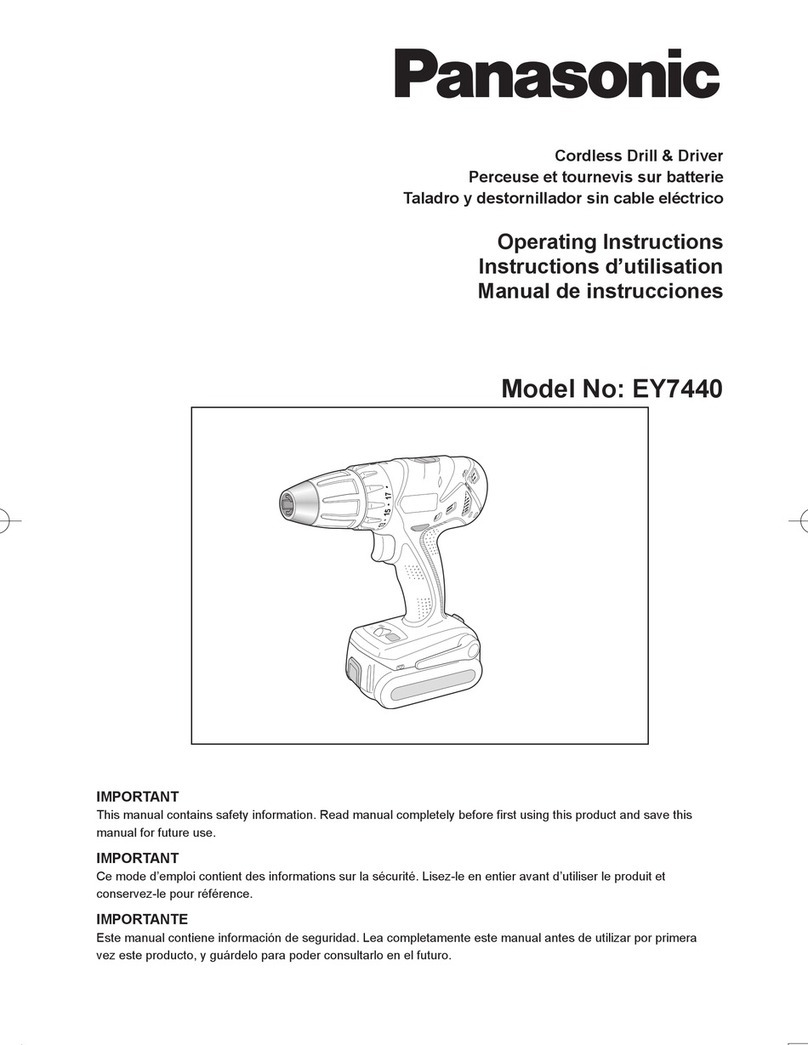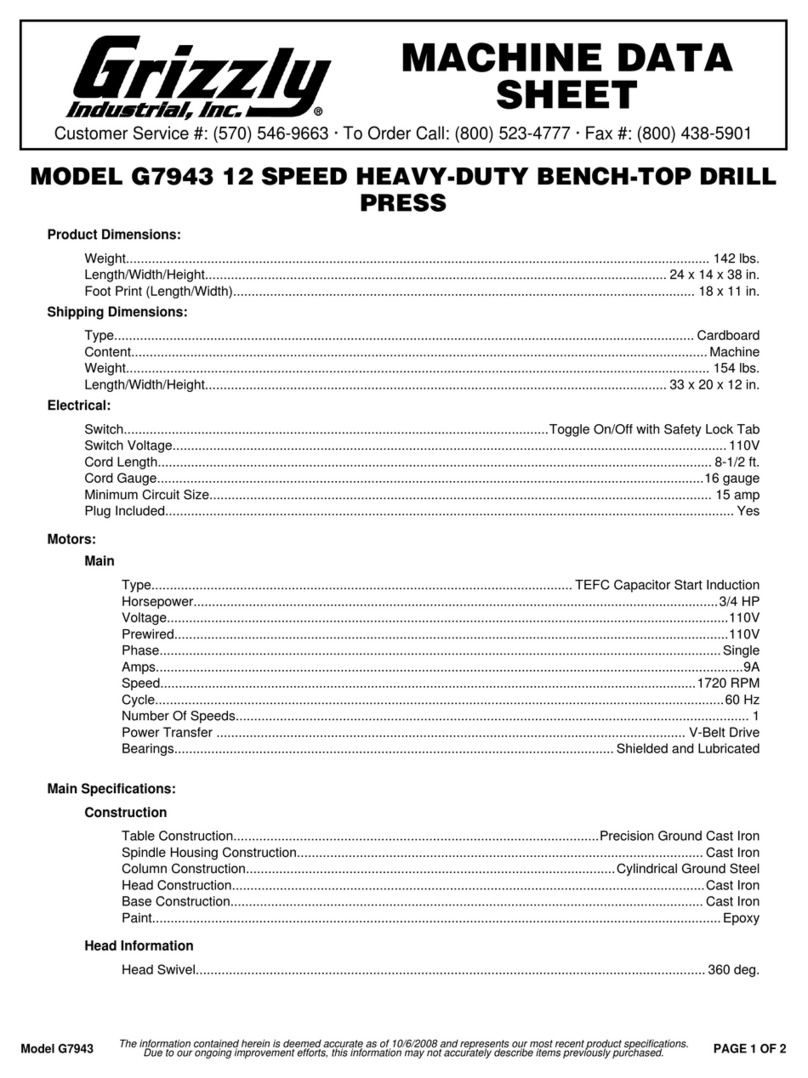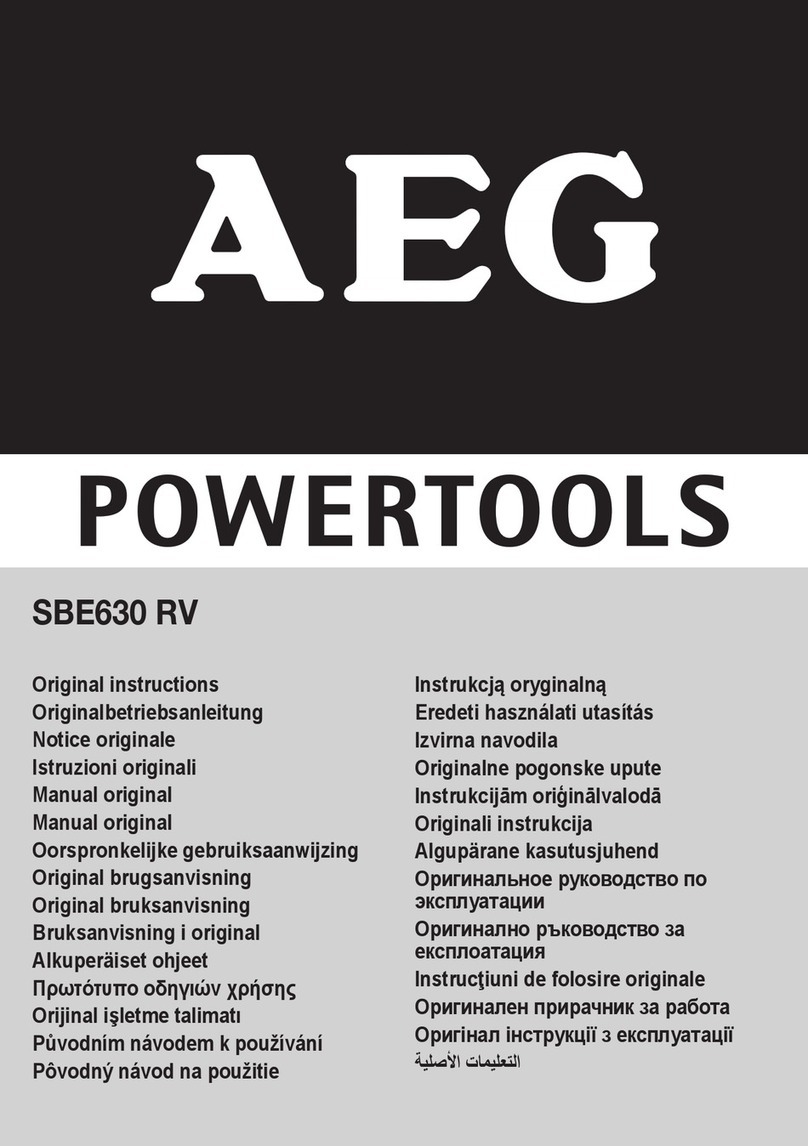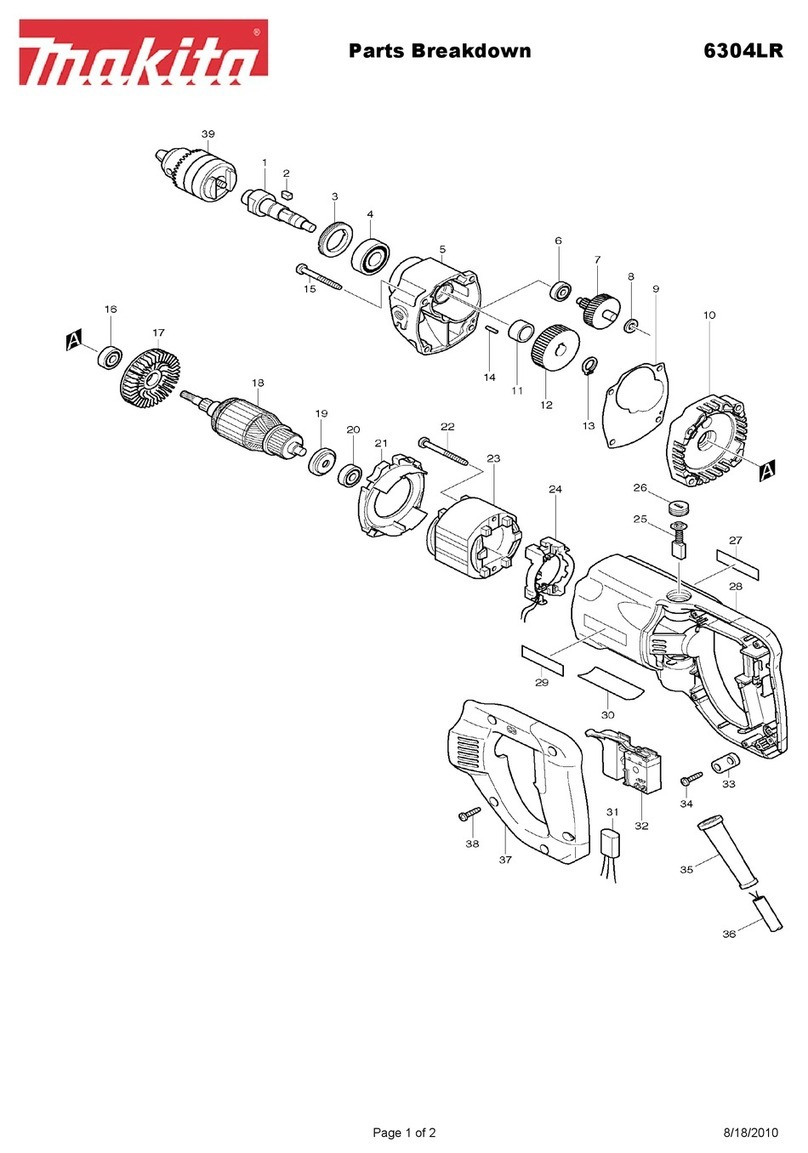Tanaka TED-270PFL, TED-270PFLS, TED-270PFR, TED-270PFRS, TED-270PFHS, TED-270PFDH,... User manual

TED-270PFL/PFLS
TED-270PFR/PFRS
TED-270PFHS/PFDH
TED-270PFDLS
Owner's manual
Mode d’emploi
Manuale d’istruzioni
Bedienungsanleitung
Manual del propietario
Gebruiksaanwijzing
Manual do proprietário
¤¥
970-81020-200 2007.07

TED-270
GB-1
TED-270PFL/PFLS
TED-270PFR/PFRS
TED-270PFHS/PFDH
TED-270PFDLS
Owner's manual
Read the manual carefully before
operating this machine.

TED-270
GB-2
The engine exhaust from this product
contains chemicals known to the State of
California to cause cancer, birth defects
and other reproductive harm.
WARNING
Read, understand and follow all warnings and
instructions in this manual and on the unit.
Always wear eye, head and ear protectors when
using this unit.
It is important that you read, fully understand
and observe the following safety precautions
and warnings. Careless or improper use of the
unit may cause serious or fatal injury.
Explains choke position. Upper sign
indicates choke closed and the lower fully
open.
Do not touch the bit when running the
engine.
Read the manual carefully.
Check that the cutting equipment is correctly assembled and adjusted.
Start the unit and check the carburetor adjustment. See "Maintenance".
Before using your machine
WARNING:
Some dust created by power sanding, sawing, grinding, drilling, and other construction
activities contains chemicals known to the State of California to cause cancer, birth
defects or other reproductive harm. Some examples of these chemicals are:
• Lead from lead-based paints,
• Crystalline silica from bricks and cement and other masonry products, and
• Arsenic and chromium from chemically-treated lumber.
Your risk from these exposures varies, depending on how often you do this type
of work. To reduce your exposure to these chemicals: work in a well ventilated area,
and work with approved safety equipment, such as those dust masks that are specially
designed to filter out microscopic particles.

TED-270
GB-3
We, Nikko Tanaka Engineering Co., Ltd., 3-4-29 Tsudanuma, Narashino, Chiba, Japan
Declare under our sole responsibility that the product, Engine drill model
to which this declaration relates is in conformity with the essential safety requirements of directives.
98/37/EC, 89/336/EEC, 2000/14/EC
The following standards have been taken into consideration
Manufactured at : Chiba, Japan
Signature:
Position : Director
TED-270PFL/PFLS
TED-270PFR/PFRS
TED-270PFHS/PFDH
TED-270PFDLS
ISO 3864 (EN ISO 12100-1/2)
What is what?
Warnings and safety instructions
Assembly procedures
Operating procedures
Maintenance
Specifications
4
5
6
6
10
12
Index
Serial No. up from E001001
on the 01/01/2008
Yoshio Osada

TED-270
GB-4
1. What is what?
1.Handle
2.Plug cap
3.Ignition switch
4.Muffler
5.Chuck unit
6.Throttle trigger
7.Recoil starter
8.Gear case
9.Fuel cap
10.Fuel tank
11.Shift lever
12.Air cleaner
13.Hole for strap
Since this manual covers several models, there may
be some difference between pictures and your unit.
Use the instructions that apply to your unit.

TED-270
GB-5
Always wear a safety face shield or
goggles.
Always wear heavy, long pants, boots
and gloves. Do not wear loose clothing,
jewelry, short pants, sandals or go
barefoot. Secure hair so it is above
shoulder length.
Do not operate this unit/machin when
you are tired, ill or under the influence of
alcohol, drugs or medication.
Never let a child or inexperienced person
operate the machine.
Wear hearing protection.
Never start or run the engine inside a
closed room or building. Breathing
exhaust fumes can kill.
Keep handles free of oil and fuel.
Keep hands away from drilling
equipment.
Do not grab or hold the unit by the drilling
equipment.
When the unit is turned off, make sure
the drilling attachment has stopped
before the unit is set down.
When operation is prolonged, take a
break from time to time so that you may
avoid possible whitefinger disease which
is caused by vibration.
Inspect the entire unit/machine before
each use. Replace damaged parts.
Check for fuel leaks and make sure all
fasteners are in place and securely
tightened.
Replace parts that are cracked, chipped
or damaged in any way before using the
unit/machine.
Keep others away when making
carburetor adjustments.
Use only accessories as recommended
for this unit/machine by the manufacturer.
Move at least 3 m away from fueling site
before starting engine.
Stop engine before removing fuel cap.
Empty the fuel tank before storing the
unit/machine. It is recommended that the
fuel be emptied after each use. If fuel is
left in the tank, store so fuel will not leak.
Store unit/machine and fuel in area
where fuel vapors cannot reach sparks or
open flames from water heaters, electric
motors or switches, furnaces. etc.
Mix and pour fuel outdoors and where
there are no sparks or flames.
Use a container approved for fuel.
Do not smoke or allow smoking near fuel
or the unit/machine or while using the
unit/machine.
Wipe up all fuel spills before starting
engine.
Fuel safety
Unit / machine safety
Do not drill any material other than that
for which is intended.
Inspect the area to be drilled before each
use. Remove objects which can be
thrown or become entangled.
For respiratory protection, wear an
aerosol protection mask when drilling the
area after insecticide is scattered.
Keep others including children, animals,
bystanders and helpers outside the 5 m
hazard zone. Stop the engine
immediately if you are approached.
Hold the unit/machine firmly with both
hands.
Keep firm footing and balance. Do not
over-reach.
Keep all parts of your body away from
the muffler and drilling attachment when
the engine is running.
Drilling safety
Maintain the unit/machine according to
recommended procedures.
Disconnect the spark plug before
performing maintenance except for
carburetor adjustments.
Keep others away when making
carburetor adjustments.
Use only genuine Tanaka replacement
parts as recommended by the
manufacturer.
Maintenance safety
2. Warnings and safety instructions
Operator safety
WARNING!
Never modify the unit/machine in any
way. Do not use your drilling tool for
any job except that for which it is
intended.
WARNING!
Antivibration systems do not guarantee
that you will not sustain whitefinger
disease or carpal tunnel syndrome.
Therefore, continual and regular users
should monitor closely the condition of
their hands and fingers. If any of the
above symptoms appear, seek medical
advice immediately.
Carry the unit/machine by hand with the
engine stopped and the muffler away
from your body.
Allow the engine to cool, empty the fuel
tank, and secure the unit/machine before
storing or transporting in a vehicle.
Empty the fuel tank before storing the
unit/machine, It is recommended that the
fuel be emptied after each use. If fuel is
left in the tank, store so fuel will not leak.
Store unit/machine out of the reach of
children.
Clean and maintenance the unit carefully
and store it in a dry place
Make sure engine switch is off when
transporting or storing.
When transporting in a vehicle, cover bit
with bit cover or rug.
Transport and storage
WARNING!
Indicates a strong possibility of severe
personal injury or loss of life, if
instructions are not followed.
CAUTION!
Indicates a possibility of personal injury or
equipment damage, if instructions are not
followed.
NOTE!
Helpful information for correct function and
use.
If situations occur which are not covered
in this manual, take care and use common
sense. Contact Tanaka dealer if you need
assistance. Pay special attention to
statements preceded by the following
words:

TED-270
GB-6
If the keylesschuck is equipped, loosen chuck
and insert drill bit. Then tighten chuck by
turning clockwise till making “click” noise
(Fig.1-1D)
Choose a drill bit according to material to be
drilled.
3. Assembly procedures
Assembling (Fig. 1-1, 1B, 1C)
1. Assemble the handle (1) witch is supplied
with the unit to the gear case.
2. Screw the chuck unit (2) into the drive shaft
(clockwise) after the collar B (3) has been
installed. (if so equipped)
3. Insert the drill bit to be used after opening the
chuck by the chuck handle (4) and tighten the
chuck by the handle.
NOTE!
Selection of a Suitable Bit
Fig.1-1 Fig.1-1CFig.1-1B
Always use branded 89 octane unleaded
gasoline.
Use genuine two-cycle oil or use a mix
between 25:1 to 50:1, please consult the oil
bottle for the ratio or Tanaka dealer
Only for the state of California at 50:1.
If genuine oil is not available, use an anti-
oxidant added quality oil expressly labeled for
air-cooled 2-cycle engine use(JASO FC
GRADE OIL or ISO EGC GRADE). Do not use
BIA or TCW (2-stroke water-cooling type)
mixed oil.
Never use multi-grade oil (10 W/30) or waste
oil.
Always mix fuel and oil in a separate clean
container.
4. Operating procedures
Fuel (Fig. 2-1)
Fuel Before fueling, clean the tank cap area carefully,
to ensure that no dirt falls into the tank. Make
sure that the fuel is well mixed by shaking the
container, before fueling.
Always shut off the engine before refueling.
Slowly open the fuel tank, when filling up
with fuel, so that possible over-pressure
disappears.
Tighten the fuel cap carefully, after fueling.
Always move the unit at least 3 m (10 ft.)
from the fueling area before starting.
Fueling
WARNING!
WARNING!
Fig.1-1D Fig.2-1
The power drill is equipped with a two-
stroke engine. Always run the engine on
fuel, which is mixed with oil.
Provide good ventilation, when fueling or
handling fuel.
Always start by filling half the amount of fuel,
which is to be used. Then add the whole
amount of oil. Mix (shake) the fuel mixture. Add
the remaining amount of fuel.
Mix (shake) the fuel-mix thoroughly before filling
the fuel tank.

TED-270
GB-7
1. Set ignition switch (1) to ON position.
(Fig. 2-2, 2B)
*Push priming bulb (4) several times so that
fuel flows through the bulb or return pipe.
(If so equipped) (Fig. 2-3)
2. Set choke lever to CLOSED position.
(Fig. 2-3)
3. Pull recoil starter briskly, taking care to keep
the handle in your grasp and not allowing it
to snap back. (Fig. 2-4)
4. When you hear the engine want to start,
return choke lever to RUN position (open).
Then pull recoil starter briskly again.
(Fig. 2-3)
NOTE!
If engine does not start, repeat procedures from
2 to 4.
5. After starting engine, allow the engine about
2-3 minutes to warm up before subjecting it
to any load.
Fig. 2-4
Starting
Fig. 2-2 Fig. 2-2B Fig. 2-3
/.
34/0
34/0 /.
TED-270PFL/270PFLS/
270PFDH/270PFDLS

TED-270
GB-8
Fig. 2-5 Fig. 2-5B
Fig. 2-5D
Fig. 2-5C
Always hold unit firmly with both hands
on handles and body well balanced.
Operate at a high engine speed and let
drill bit do the work. Do not force bit into
hole.
If material become twisted around drill
bit, stop engine, allow unit to cool and
remove wire from spark plug before
attempting to clear bit.
Stop engine and inspect unit if abnormal
vibration or noise is generated.
How to operate Lock control
(on TED270PFL/270PFLS/270PFDH/
270PFDLS) (Fig. 2-5C)
NOTE!
Always stop the engine before operation of
lock contorol.
When bit has stuck in object, stop engine
and turn on lock lever (1).
Rotate whole unit counter-clockwise so
that the bit can be pulled out easily.
If the unit would not move, rotate it
clockwise a little and then counter-
clockwise again.
Drilling (Fig. 2-5, 5B)
Decrease engine speed to idle and move
shift lever (2) to R (Reverse) position,
then accelerate to pull out.
Shift lever may not move unless engine
is running. If so, turn drill chuck a little bit
by hand.
* The purpose of Lock control and
Reverse control is mainly for easy
pullout of bit.
How to operate Reverse control
(on TED-270PFR/270PFRS)
(Fig. 2-5D)
TED-270PFL/270PFLS/
270PFDH/270PFDLS

TED-270
GB-9
Note! use chuck mount wrench (3) in
place of chuck handle and tighten or
untighten manually instead of hitting. Do
not hit the chuck mount wrench.
(Fig. 2-7, 7B)
To install or loosen the keyless chuck, set
a 19mm spanner (1) between gear case
and chuck to lock drive shaft. Install the
locking bar (2) in the tool bag into the
chuck, and then tighten(clockwise) the bar
(2) with the enclosed box spanner or
loosen (counter-clockwise) . (Fig.2-7C)
Stopping (Fig. 2-8, 8B)
Decrease engine speed, and push ignition
switch to stop position.
Fig. 2-8B
Fig. 2-6 Fig. 2-7Fig. 2-6B
Fig. 2-7B Fig. 2-8Fig. 2-7C
To tighten the chuck more securely, set a
19mm spanner (1) between gear case
and drill chuck to lock drive shaft. Turn
on lock lever (2) then hit the mounted
chuck handle with a hammer to screw in
(clockwise) the chuck. (TED-270PFL/
270PFLS/270PFDH/270PFDLS/270PFHS
)
(Fig. 2-6)
To loosen the chuck, set the spanner on
the other side and hit the chuck handle
from this side to screw out (counter-
clockwise), the chuck with the lock lever
on.(TED-270PFL/270PFLS/270PFDH/
270PFDLS/270PFHS) (Fig. 2-6B)
/.
34/0
34/0 /.
TED-270PFL/270PFLS/
270PFDH/270PFDLS

TED-270
GB-10
Fig. 3-3
Fig. 3-4BFig. 3-4
5. Maintenance
MAINTENANCE. REPLACEMENT, OR RE-
PAIR OF THE EMISSION CONTROL DE-
VICES AND SYSTEM MAY BE PERFORMED
BY ANY NONROAD ENGINE REPAIR ES-
TABLISHMENT OR INDIVIDUAL.
Carburetor adjustment (Fig. 3-1)
WARNING!
The bit may be spinning during carburetor
adjustments.
WARNING!
Never start the engine without the complete
clutch cover and gear case assembled!
Otherwise the clutch can come loose and
cause personal injuries.
In the carburetor, fuel is mixed with air. When
the engine is test run at the factory, the
carburetor is adjusted. A further adjustment may
be required, according to climate and altitude.
The carburetor has one adjustment possibility:
T = Idle speed adjustment screw.
Idle speed adjustment (T)
Check that the air filter is clean. When the idle
speed is correct, the bit will not rotate. If
adjustment is required, close (clockwise) the T-
screw, with the engine running, until the bit
starts to rotate. Open (counter-clockwise) the
screw until the bit stops. You have reached the
correct idle speed when the engine runs
smoothly in all positions well below the rpm
when the bit starts to rotate.
If the bit still rotates after idle speed adjustment,
contact Tanaka dealer.
WARNING!
When the engine is idling the bit must under
no circumstances rotate.
Air filter (Fig. 3-2)
The air filter must be cleaned from dust and dirt
in order to avoid:
Carburetor malfunctions.
Starting problems.
Engine power reduction.
Unnecessary wear on the engine parts.
Abnormal fuel consumption.
Clean the air filter daily or more often if working
in exceptionally dusty areas.
Cleaning the air filter
Remove the air filter cover and the filter. Rinse
it in warm soap suds. Check that the filter is dry
before reassembly. An air filter that has been
used for some time cannot be cleaned com-
pletely. Therefore. it must regularly be replaced
by a new one. A damaged filter must always be
replaced.
NOTE!
Saturate the element in 2 cycle oil or the
equivalent. Squeeze the element to distribute
the oil completely and to remove any excess oil.
Spark plug (Fig. 3-3)
The spark plug condition is influenced by:
An incorrect carburetor setting.
Wrong fuel mixture (too much oil in the
gasoline)
A dirty air filter.
Hard running conditions (such as cold
weather).
These factors cause deposits on the spark plug
electrodes, which may result in malfunction and
starting difficulties. If the engine is low on
power, difficult to start or runs poorly at idling
speed, always check the spark plug first. If the
spark plug is dirty, clean it and check the
electrode gap. Readjust if necessary. The
correct gap is 0.6 mm (.024"). The spark plug
should be replaced after about 100 operation
hours or earlier if the electrodes are badly
eroded.
NOTE!
In some areas, local law requires using a
resistor spark plug to suppress ignition signals.
If this machine was originally equipped with
resistor spark plug, use same type of spark plug
for replacement.
Gear case (Fig. 3-4, 4B)
Apply a good quality lithium based grease
through the grease fitting. Lubrication should be
applied at 50 hour intervals and more frequent
at heavy use.
Fig. 3-1 Fig. 3-2
T

TED-270
GB-11
Fig. 3-5 Fig. 3-6
Fig. 3-7
Fuel filter (Fig. 3-5)
Remove the fuel filter from the fuel tank and
thoroughly wash it in solvent. After that, push
the filter into the tank completely.
NOTE !
If the filter is hard due to dust and dirt, replace
it.
Cleaning the cylinder fins (Fig. 3-6)
When wood chips are caught between cylinder
fins, the engine may overheat, resulting in
lower output. To avoid this, always keep
cylinder fins and fan case clean.
Every 100 Operating hours, or once a year
(more often if conditions require), clean fins and
external surfaces of engine of dust, dirt and oil
deposits which can contribute to improper
cooling.
Cleaning the muffler (Fig. 3-7)
Remove the muffler and spark arrestor (if so
equipped), and clean out any excess carbon
from the exhaust port or muffler inlet every 100
hours of operation.
For long-term storage
Drain all fuel from the fuel tank. Start and let
engine run until it stops. Repair any damage
which has resulted from use. Clean the unit
with a clean rag, or the use of high pressure air
hose. Put a few drops of two-cycle engine oil
into the cylinder through the spark plug hole,
and spin the engine over several times to
distribute oil. Cover the unit and store it in a dry
area.
Maintenance schedule
Below you will find some general maintenance
instructions. For further information please
contact Tanaka dealer.
Daily maintenance
Clean the exterior of the unit.
Check that the drilling attachment is properly
centred, sharp, and without cracks. An
offcentred bit induces heavy vibrations that
may damage the unit.
Chock that the drilling attachment is
sufficiently tightened.
Check that nuts and screws are sufficiently
tightened.
Weekly maintenance
Check the starter, especially cord and return
spring.
Clean the exterior of the spark plug.
Remove it and check the electrode gap.
Adjust it to 0.6 mm, or change the spark plug.
Clean the cooling fins on the cylinder and
check that the air intake at the starter is not
clogged.
Check that the angle gear is filled with grease
up to 3/4.
Clean the air filter.
Monthly maintenance
Rinse the fuel tank with gasoline.
Clean the exterior of the carburetor and the
space around it.
Clean the fan and the space around it.

TED-270
GB-12
6. Specifications
Engine Size (ml) ...............................
Spark Plug .......................................
Fuel Tank Capacity ( l )......................
Dry Weight (kg)..................................
Chuck Capacity (mm)........................
Drive Shaft Diameter..........................
Max. Bit Size (mm).............................
(Wood)
Reverse Control..................................
Lock Control........................................
Sound pressure level (dB(A)) ...........
(EN 27917)
Sound power level (db(A))................
Vibration level (m/s2) (ISO 7916)
Front handle .............................
Rear handle ..............................
MODEL TED-270PFL/
TED-270PFLS
TED-270PFR/
TED-270PFRS
TED-270PFHS
5.1 (11.2 lbs) 5.6 (12.3 lbs) 5.0 (11.0 lbs)
12.7 (1/2 in)
○
○
1/2''-20 UNF
25.4 (1 in)
LpA
95.1 95.1 95.1
7.1
7.2
7.1
7.2
7.1
7.2
LwA
116 116 116
NOTE : Equivalent noise level/vibration level are calculated as the time-weighted energy total for noise/vibration levels under various working
conditions with the following time distribution : 1/2 idle, 1/2 racing.
*All data subject to change without notice.
26.9 (1.64 cu. in.)
Champion CJ-8
or equivalent
0.67 (22.8 fl. oz)

TED-270
GB-13
Engine Size (ml) ...............................
Spark Plug ........................................
Fuel Tank Capacity ( l )......................
Dry Weight (kg)..................................
Chuck Capacity(mm).........................
Drive Shaft Diameter..........................
Max. Bit Size (mm).............................
(Wood)
Reverse Control..................................
Lock Control.......................................
Sound pressure level (dB(A)) ...........
(EN 27917)
Sound power level (db(A))................
Vibration level (m/s2) (ISO 7916)
Front handle .............................
Rear handle ..............................
TED-270PFDH TED-270PFDLS
6.66.6
0.67 (22.8 fl. oz)
Champion CJ-8
or equivalent
26.9 (1.64 cu. in.)
12.7(1/2 in)
○ ○
1/2''-20 UNF
25.4 (1 in)
LpA
94.0 94.1
7.81
5.66
Right 6.50
Left 6.76
LwA
104 104
NOTE : Equivalent noise level/vibration level are calculated as the time-weighted energy total for noise/vibration levels under various working
conditions with the following time distribution : 1/2 idle, 1/2 racing.
*All data subject to change without notice.
MODEL

TED-270
GB-14

FR-1
TED-270
TED-270PFL/PFLS
TED-270PFR/PFRS
TED-270PFHS/PFDH
TED-270PFDLS
Mode d’emploi
Lire attentivement le manuel avant
d’utiliser la machine.

FR-2
TED-270
Explique la position de l’étrangleur. La
marque supérieure indique que l’étrangleur
est fermé et la marque inférieure qu’il est
complètement ouvert.
Ne touchez en aucun cas la mèche quand
le moteur fonctionne.
Les gaz d'échappement du moteur de
cette machine contiennent des produits
chimiques considérés comme pouvant
causer des cancers, des malformations
congénitales et autres troubles de la
reproduction.
ATTENTION!
Lisez, comprenez et suivez toutes les
instructions et tous les avertissements
donnés dans ce manuel et sur la machine.
Utilisez toujours des lunettes de protection ainsi
qu'une protection pour la tête et les oreilles
lorsque vous utilisez cette machine.
II est essentiel que vous lisiez et compreniez
parfaitement les consignes de sécurités
suivantes et autres avertissements et que vous
les observiez strictement. L'utilisation
inattentive ou inadéquate de cette unité risque
de provoquer des blessures graves ou fatales.
Lire attentivement le manuel d'utilisation.
Vérifier que l'équipement de coupe est monté et réglé correctement.
Démarrer la machine et vérifier le réglage du carburateur. Voir "Entretien".
Avant l'utilisation de votre nouvelle machine
AVERTISSEMENT:
La poussière résultant d'un ponçage, d'un sciage, d'un meulage, d'un perçage ou de toute
autre activité de construction renferme des produits chimiques qui sont connus par l'Etat
de Californie pour causer des cancers, des défauts de naissance et autres anomalies de
reproduction. Nous énumérons ci-dessus certains de ces produits chimiques:
• Plomb des peintres à base de plomb,
• Silice cristalline des briques et du ciment et autres matériaux de maçonnerie, et
• Arsenic et chrome du bois d'oeuvre traite chimiquement.
Le risque d'exposition à ces substances varie en fonction de la fréquence d'exécution de
ce genre de travail. Pour réduire l'exposition à ces produits chimiques, travailler dans un
lieu bien ventilé, et porter un équipement de protection agréé, par exemple un masque
anti-poussière spécialement conçu pour filter les particules microscopiques.

FR-3
TED-270
Nous,soussignés, Nikko Tanaka Engineering Co., Ltd., 3-4-29 Tsudanuma, Narashino, Chiba, Japan
Déclarons sous notre seule responsabilité que le produit en question, perceuse modèle
à laquelle se rapporte la présente déclaration est conforme aux directives concernant les conditions de
sécurité essentielles.
98/37/EC, 89/336/EEC, 2000/14/EC
Les normes suivantes ont été prises en considération.
Fait à : Chiba, Japan
Signature :
Function : Direeteur
TED-270PFL/PFLS
TED-270PFR/PFRS
TED-270PFHS/PFDH
TED-270PFDLS
ISO 3864 (EN ISO 12100-1/2)
Description
Précautions et consignes de sécurité
Montage
Utilisation
Entretien
Caractéristiques
4
5
6
6
10
12
Index
Le 01/01/2008
No. de série à partir de E001001
Yoshio Osada

FR-4
TED-270
1. Description
1.Levider de support
2.Capuchon de bougie
3.Interrupteur marchearrêt
4.Silencieux d’echappement
5.Bloc de mandrin
6.Levier de l’accélérateur
7.Demarreur a recul
8.Boite d’emgrenages
9.Bouchon de remplissage du carburant
10.Reservoir de carburant
11.Levier de changement
12.Filtre a air
13.Trou de courroie
Comme ce manuel se réfère à plusieurs modèles, il
se peut qu’il y ait de différences entre les images et
votre appareil. Suivez les instructions concernant
votre modèle.

FR-5
TED-270
Portez toujours une visière et des lunettes de
protection.
Portez toujours un pantalon, des chaussures
et des gants de sécurité. Evitez les vêtements
amples, les shorts, les sandales et les pieds
nus. Veillez à ce que vos cheveux ne
descendent pas au-dessous des épaules.
N’utilisez cette machine que si vous êtes en
pleine possession de vos moyens physiques.
Evitez strictement la consommation d’alcool,
de drogue ou de médicaments.
Ne jamais laisser un enfant ou une personne
inexpérimentée se servir de ces machines,
Portez un dispositif de proteclion contre le
bruit pour vos oreilles.
Ne mettez jamais le moteur en marche dans
un local clos, les gaz d'échappement étant
toxiques.
Nettoyez les poignées de toute trace d'huile
ou de carburant.
Ne pas approcher les mains du dispositif de
forage.
Ne pas saisir ou tenir l’unité par le dispositif de
forage.
Lorsque l’on arrête l’unité, veiller à ce que le
dispositif de forage soit complètement arrêté
avant de poser l’unité.
Lors d'une utilisation prolongée, veillez à faire
une pause périodiquement, afin d'éviter des
troubles éventuels provoqués par les
vibrations.
Vidangez le réservoir de carburant avant de
remiser la machine II est en fait recommandé de
le faire après chaque utilisation. Si le réservoir
n'est pas vide, rangez alors la machine dans
une position telle que le carburant ne risque pas
de couler.
Rangez la machine et le carburant dans un
endroit où les vapeurs d'essence ne risquent
pas d'entrer en contact avec des étincelles ou
une flamme en provenance d'un chauffe-eau,
d'un moteur électrique, d'un commutateur,
d'une chaudière, etc.
Faites le mélange et le plein à l'air libre, à
distance de toute étincelle ou flamme
Utilisez pour l'essence un récipient agréé.
Ne fumez pas et ne laissez personne fumer à
proximité du carburant ou de la machine.
ni lorsque vous utilisez la machine.
Essuyez soigneusement toutes les traces de
carburant avant de mettre le moteur en
marche.
Pour démarrer la tronçonneuse, écartez vous
d'au moins 3 mètres de l'endroit où vous avez
fait le plein.
Arrêtez le moteur avant de dévisser les
bouchons des réservoirs de carburant ou
d'huile.
Sécurité au niveau du carburant
Contrôlez entièrement votre machine avant
chaque utilisation. Remplacez les pièces
endommagées. Vérifiez l'absence de fuites de
carburant et assurez-vous que tous les
dispositifs de fixation sont en place et
solidement fixés.
Remplacez les éléments Tanaka de la
machine qui présentent des fissures, des
ébréchures ou toute autre avarie.
Ne laissez personne s'approcher lorsque vous
réglez le carburateur.
Utilisez uniquement les accessoires
recommandés par le constructeur pour cette
machine.
Règles de sécurité concernant l'utilisation de
la machine.
Consignes de sécurlté concernant le forage
Entretenez votre machine selon les
recommandations du constructeur,
Débranchez la bougie avant toute intervention
intervention d'entretien, à l'exception des
opérations de réglages du carburateur.
Ne laissez personne s'approcher de la
machine lorsque vous procédez au réglage du
carburateur.
N’utilisez que les pièces de remplacement
Tanaka d’origine comme recommandé par le
fabricant.
Sécurité au niveau de l'entretien
Ne jamais forer de matériaux autres que ceux
pour lesquels l’unité a été conçue.
In specter la zone à forer à chaque fois avant
de commencer les opérations. Enlever tout ce
qui risque d’être projeté ou de s’enmêler.
Pour la protection des voies respiratoires,
porter un masque de protection contre les
aérosols lorsque l’on fore une zone traitée
avec des insecticides.
Veillez à ce que personne, enfants, animaux,
spectateurs ou aides ne se tienne à l’int•rieur
de la zone de sécurité de 5 mètres. Arrêtez
immédiatement le moteur si quelqu’un
s’approche de vous.
Maintenez fermement la machine des deux
mains.
Tenez vous bien en équilibre sur vos deux
jambes. Ne travaillez jamais en porte-à-faux.
Demeurer toujours à une distance respectable
du silencieux d’echappement et du dispositif
2. Précautions et consignes de sécurité
Sécurité de l'utilisateur
ATTENTION!
Ne modifiez en aucun cas l’équipement. Ne
jamais utiliser l’outil de forage pour tout
autre travail que celui auquel il est destiné.
ATTENTION!
Les systèmes anti-vibrations, aussi bon
soient-ils, ne garantissent pas que vous ne
puissiez pas souffrir de la maladie des
doigts blancs, ni du syndrome du canal
carpien. Par conséquent, si vous vous
servez de façon régulière et continue de
votre tronçonneuse, surveillez
soigneusement l'état de vos mains et de vos
doigts. Si l'un des symptômes ci-dessus
venait à apparaître, il serait indispensable
de vous faire examiner immédiatement par
votre médecin.
Remisez la machine hors de portée des
enfants.
Nettoyer et entretenir l’outil soigneusement et
le remiser dans un endroit sec.
Assurez vous que le commutateur d'arrêt du
moteur est bien sur la position "stop" lors du
transport ou du remisage de la machine.
Lors du transport de l’équipement dans un
véhicule, couvrir l’outil tranchant avec le
couvercle de protection ou une couverture.
ATTENTION!
Information de première importance pour éviter
des dommages corporels graves ou mortels.
IMPORTANT!
Information importante afin d'éviter les
dommages corporels ou matériels.
REMARQUE!
Information importante pour la compréhension
d'une intervention, évitant ainsi des erreurs.
Portez la machine avec moteur arrêté et
silencieux orienté vers l'extérieur.
Laissez le moteur refroidir, videz le réservoir
de carburant et veillez à ce que la machine ne
risque pas de tomber lorsque vous la rangez
ou la chargez à bord d'un véhicule.
Vidangez le réservoir de carburant avant de
remiser la machine, II est en fait recommandé
de le faire après chaque utilisation. Si le
réservoir n'est pas vide, rangez alors votre
tronçonneuse dans une position telle que le
carburant ne risque pas de couler.
Transport et rangement
Si vous rencontrez une situation non prévue
dans le manuel, utilisez votre jugement et votre
bon sens.
Communiquez avec un
concessionnaire Tanaka pour toute assistance.
Dans les textes qui suivent, les passages
particulièrement importants sont mis en
évidence de trois manières différentes selon
leur niveau de risque ou la gravité des
dommages qui peuvent en résulter:
This manual suits for next models
8
Table of contents
Languages:
Other Tanaka Drill manuals

Tanaka
Tanaka TED-260 Instruction Manual
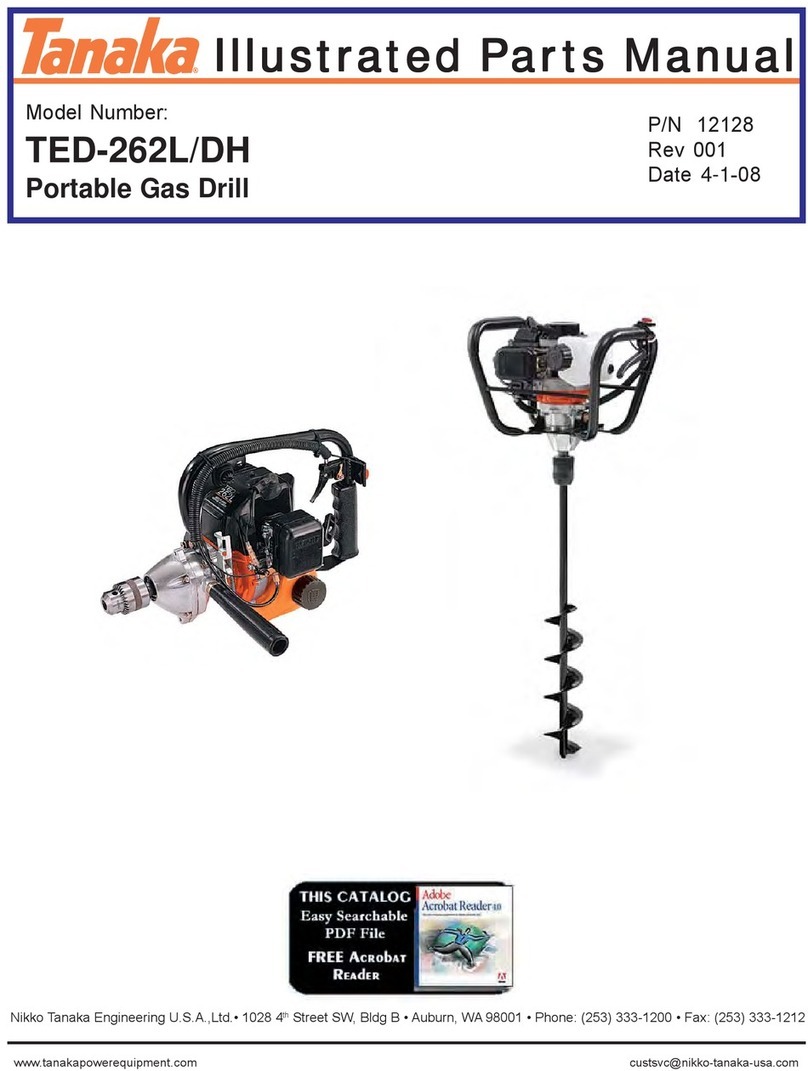
Tanaka
Tanaka TED-262L Setup guide
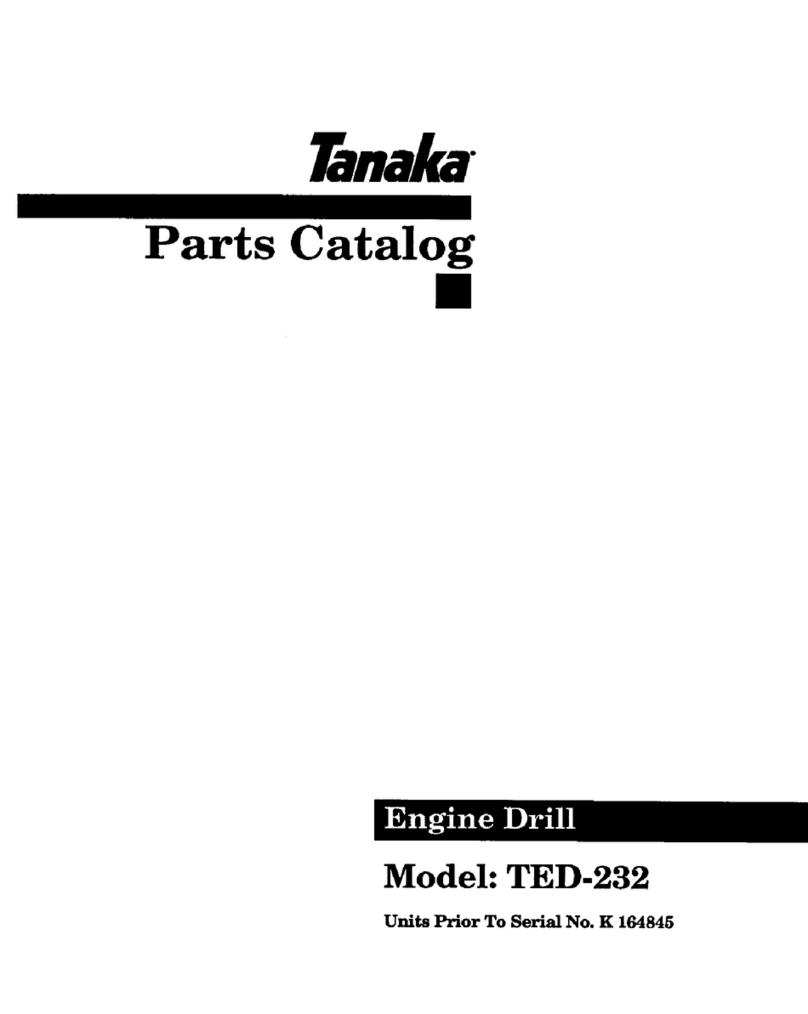
Tanaka
Tanaka TED-232 Instruction Manual

Tanaka
Tanaka TED-270PFL User manual
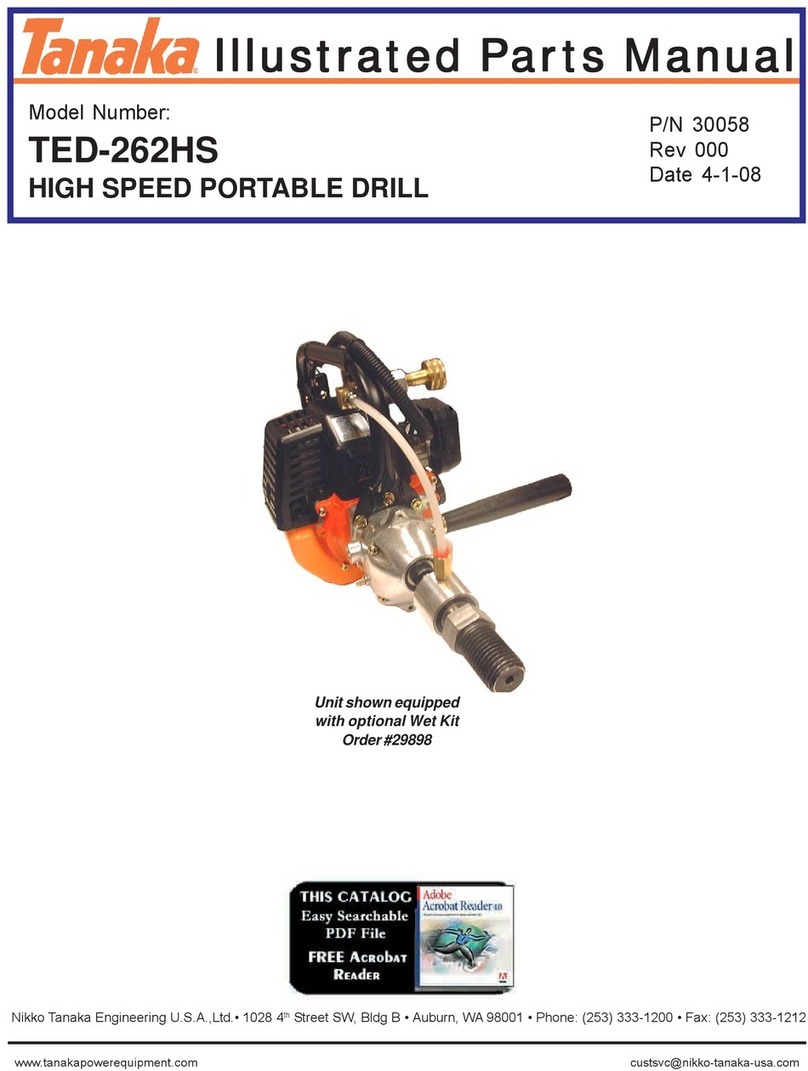
Tanaka
Tanaka TED-262HS Setup guide
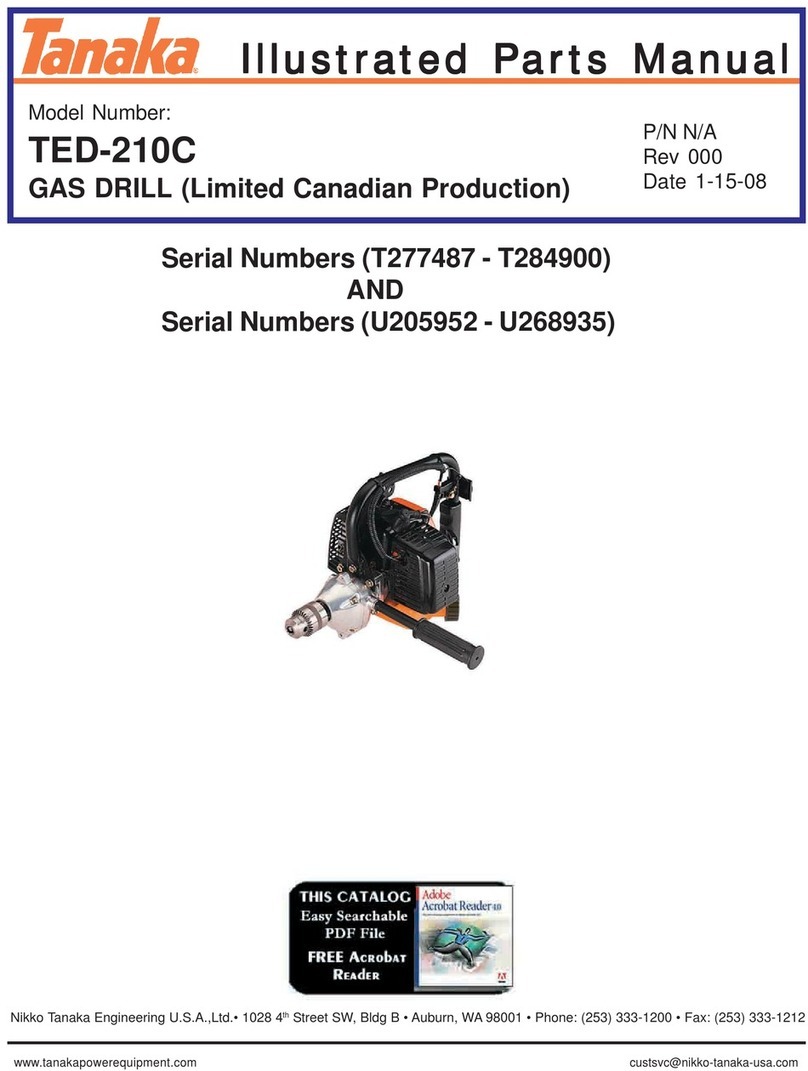
Tanaka
Tanaka T277487 Setup guide

Tanaka
Tanaka TED-262DH User manual

Tanaka
Tanaka TED-210 User manual

Tanaka
Tanaka TED-210 User manual
